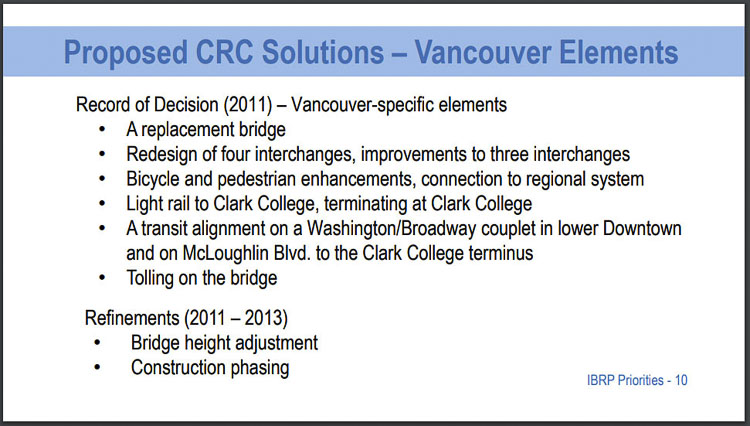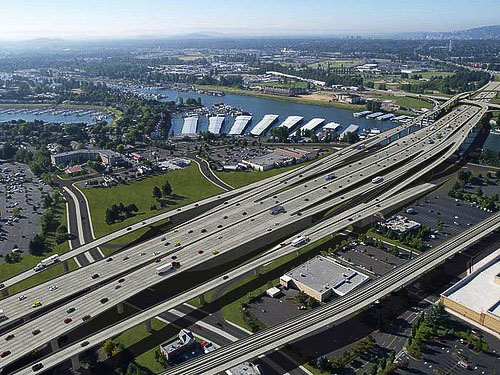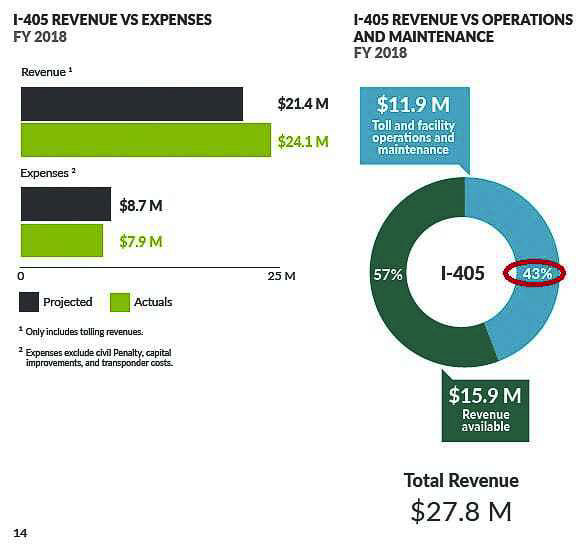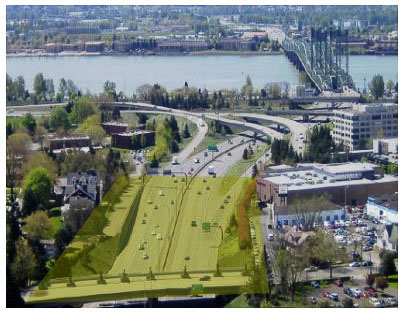Council members attempting to be sufficiently briefed on the details of tolling
Members of the Vancouver City Council have been discussing their desires and preferences regarding the Interstate Bridge Replacement Program (IBRP). In their two most recent meetings they have shared a desire for a cover over the top of I-5 just south of Evergreen St., more connections to the waterfront, and tolling to be part of the program.
There is no specific project designed yet by the IBRP team, so Vancouver officials are hoping to influence them, weighing in with their desires on a variety of issues. The council expects to vote on a final document at their meeting July 26.
Among the issues discussed was “how many lanes” should be on the bridge? There was also discussion suggesting 10 lanes (total) with three being through lanes and two being auxiliary lanes. There was debate on how many lanes to set aside as “dedicated lanes” for transit, with one councilor suggesting two in each direction.
Among the multiple issues that led to the failure of the previous Columbia River Crossing (CRC) effort was tolling. Former Vancouver Mayor Tim Leavitt won his election against incumbent Royce Pollard, largely by fighting against the $8 tolls. Leavitt later changed his position, supporting both the tolls and the CRC project.

In the $3.5 billion CRC debate, tolling was needed to pay for borrowed money, an estimated $1.4 to $1.5 billion. Federal money was only going to pay for the cost of light rail, although early on the project had hoped to get up to an additional $400 million from Congress not assigned to transit.
During the July 13 meeting, Councilor Sarah Fox raised an objection to including support for tolling in the document as a form of demand management. She said they had not been briefed on tolling and was concerned about its impact on low income people. “If we’re going to talk about tolling, I don’t feel like we’ve had a really deep conversation about it at this point,” she said.
“I have concerns about a tolling program, if it doesn’t address some of the inequities we have in our system,” Fox said She desires a pricing scheme that recognizes different income levels, and recognizes the unique population that uses the bridge. During the CRC debate, it was estimated 60 percent or more of the tolls would be paid by Southwest Washington residents who work in Oregon.
Staff member Katherine Kelly explained tolling was included because it is actually part of the baseline, from the CRC program. That meant it was part of the federal Record of Decision (ROD) that the present IBRP team is seeking to avoid having to go through another ROD process. Kelly said it potentially had a duo purpose — payback for construction of the bridge and congestion management.
Councilor Bart Hansen shared that he felt tolls were okay to pay for the bridge and for ongoing maintenance, but he was uncomfortable with using it for congestion management.
Hansen also said he wanted to specify the bridge to be 10 lanes wide. That triggered a discussion, where people indicated they only wanted three through lanes and the rest be auxiliary lanes. Others suggested the number of lanes not be specified because the data would drive that decision.
Nobody asked questions regarding how many lanes would be needed to accommodate present, let alone future traffic demand. Transportation architect Kevin Peterson previously shared five through lanes would be needed in each direction by 2030 and eight lanes by 2060.
Earlier this month, IBRP administrator Greg Johnson shared the bridge would have three through lanes and the variable was how many auxiliary lanes would be included.
Mayor Anne McEnerny-Ogle followed comments by other council members, noting there are different types of tolling and suggesting the council be briefed on the subject before making a final decision. She was one of 25 participants in the ODOT “Value Pricing” Policy Advisory Committee (PAC) which spent roughly eight months studying tolling issues three years ago.

Congestion pricing is a variable rate toll that gets higher when there is more congestion and smaller when there is less congestion. In northern Virginia on I-66, the maximum congestion pricing toll has exceeded $47 for a one way trip into Washington, DC. Additionally, that program also had drivers paying $5.50 at 5:30 in the morning.
On I-405 east of Seattle, WSDOT uses congestion pricing for one or two lanes. Prices range from no charge to $10 depending on the number of vehicles on the road and time of day.
Other types of tolling include a flat charge per mile and a flat charge to travel a segment of the highway. Finally, there is a flat fee to use a bridge or a tolled road.
As an example, the second Tacoma Narrows Bridge opened in July 2007 and is Washington state’s only modern megaproject wholly financed by toll payers. State lawmakers originally assumed an economic boom, traffic growth and rapid increases in the $1.75 introductory tolls that would cover the $849 million construction cost.
“The state at the time didn’t set up a proper debt structure, so it was an unfair burden on drivers,” said Reema Griffith, the commission’s executive director. Motorists seethed as tolls climbed to $5.
To avoid even higher rates, the Legislature authorized loans from gas-tax revenue, to prop up the Narrows fund. That $85 million loan needs to increase to $115 million, the commission said earlier this year. A 25-cent toll increase should be the last boost until 2030, and pay off the internal loans, Griffith said.
One issue not asked by the council was how much or what price level of tolls they would support. Also, will any toll be added on top of any tolls Oregon is planning to charge drivers using I-5?
Oregon’s “Value Pricing” tolling effort has not yet decided what type, nor the level of tolls that ultimately may begin “at the border” with Washington.
One option includes changing the price depending on the time of day. For instance, drivers could end up paying a higher toll during rush hour compared to off-peak hours.
Another option: turn HOV lanes into tolled express lanes. That would give drivers the option to pay for a faster lane or drive in more congested lanes for free according to ODOT’s Don Hamilton during the initial “Value Pricing” discussion. The discussion about “free lanes” has virtually disappeared from Oregon’s tolling discussions.
There had been talk early on about mitigating the negative impacts on the poor and less fortunate, but there have been no concrete proposals by ODOT.
“As we look at mitigation, we’re hoping that you continue to realize that, again, this is a bi-state implementation, and that all of the projects have equal applicability to Oregon and Washington,” McEnerny-Ogle told the Oregon Transportation Commission (OTC) in July 2018. “Whether it’s C-TRAN and Tri-Met, look at all four counties when you look at those mitigation measures.”
“I feel like this is rather punitive, to be quite frank,” added Representative Paul Harris, a Republican from the 17th District. He was addressing the OTC during the same “listening session.”
Another issue not mentioned at the council meeting was traffic diversion. How many vehicles will divert to I-205 in order to avoid paying an Interstate Bridge toll? During the Value Pricing PAC discussion, it was revealed there were 80,000 vehicles already diverting, and tolling would cause an additional 50,000 diversions. Canby Council President Tim Dale emphatically told ODOT last year: “you’re actually going to make things worse” regarding I-205 tolling.
One news report acknowledged the traffic diversion issue in Seattle. “High tolls conflict with Seattle’s need to entice drivers off surface streets.”

Another issue is the cost of collecting tolling dollars. On Seattle’s I-405, the cost of collection was 43 percent. This year, the legislature had to bail out tolling facilities because of the huge downturn in driving due to the pandemic and the governor’s lockdown order.
For the first six months of Fiscal Year 2021, the state tolling program lost $5 million on the I-405 and SR 167 system. The state treasurer expressed concern about the state possibly defaulting on federal TIFIA loans made for SR 520 that crosses Lake Washington.
Tolling revenues are volatile. One news report showed the numbers from all the tolled facilities between March 2020 and January 2021: The Tacoma Narrows Bridge saw the smallest dip, coming in just 17 percent below the forecast; the 520 Bridge was off 54 percent; the 99 Tunnel was off 45 percent; the 167 HOT lanes were off 63 percent; and the I-405 Express Toll lanes were off 80 percent.
This level of the “cost of collection” was indirectly confirmed by ODOT’s Mandy Putney in an April 2018 presentation to the Southwest Washington Regional Transportation Council. “Some of these scenarios might not raise much more than the cost to cover the operations of the tolling system.”
Clark County Today has an extensive article on tolling here.
In the state of Washington, the state Transportation Commission sets rates, and will be meeting July 20 to determine rates on tolled roads in the state. In the case of the bridge connecting Oregon and Washington, while ODOT is responsible for maintenance, it has not been decided who would control toll rates.

The Vancouver City Council members are also hoping to have a lid over the top of I-5, similar to what Oregon is doing at the Rose Quarter, and what Seattle has for it’s convention center. There was no mention of the cost of a lid, nor of who would pay.
Councilor Ty Stober wants a connection from the bridge directly to the Renaissance Trail. The proposed document also has an emphasis on access to transit as well as facilities for pedestrians and bicyclists.
City Manager Eric Holmes promised to bring the council more information on tolling, plus make some modifications to the proposed resolution in response to council comments. The council is expected to finalize the language and approve a resolution at its July 26 meeting.




